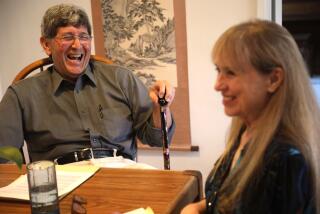Woman Crusades for Ailing Nuclear Workers, Families
MOSCOW MILLS, Mo. â When Denise Brock sat with her cancer-stricken dad in the 1960s, she made lots of racket, hoping that the noise would prevent his dying on her watch.
Today, Brock, 43, is clamoring all the louder, a full-time activist on behalf of aging Cold War-era nuclear workers and their survivors.
âIâm obsessed with this,â she said. âIf I donât help them, whoâs going to?â
A 3-year-old federal law requires the U.S. government to compensate workers in the nuclear weapons industry, or their survivors, for job-related cancer or other diseases. Workers from about 350 sites may qualify.
Ten sites are in Missouri, including the old Mallinckrodt Chemical Co. plant in St. Louis, where Brockâs father, Christopher Davis, worked from 1945 to 1960. The plant produced uranium dioxide for the Manhattan Project, exposing its workers to large doses of radiation. Brockâs father died of lung cancer in 1978. When she started helping her mother file a benefits claim in 2002, she ran into obstacles.
Employment records had been destroyed. The family could only guess what Davis was exposed to. Workers used code words like âjuice,â âbiscuitâ and âtube alloyâ to describe what they made.
Brock dug up old city directories and Social Security records to prove her fatherâs employment and hunted down documents to trace his exposure. If she failed to prove her case, her mother would not get the $150,000 payment she was due.
The experience made Brock angry and determined to act for others.
For more than a year, she has crusaded among those she calls âmy workers,â mostly elderly former plant employees, their aging spouses or children, to help them construct a picture of the years when the workers were exposed.
She founded United Nuclear Weapons Workers, which operates from her eastern Missouri mobile home. Her teenage daughter fields phone calls and inputs computer data. Her husband, an ironworker, listens calmly to her rants and drives her to meetings.
Documents from Freedom of Information Act requests fill filing cabinets in the bathroom and bedroom. Last fall, she received 5,000 pages of classified records to help claimants fill information gaps. Among them: decades-old urine analysis reports that indicated how much uranium dust a worker had inhaled and excreted.
Brockâs monthly phone bill averages $700. She regularly calls the Labor Department, which handles the claims.
Over the past year, she organized hundreds of workers and union tradesmen who risked exposure when called to the sites. She recruited a board of directors, had claims workshops and walked nervous claimants through mock telephone interviews, even providing a script.
She works for free. The payback is the hugs, letters and thanks from grateful people.
âSheâs such an energetic person; sheâs doing everything in her power to help people out,â said Harold Mauk, 82, of Farmington, Mo., who worked at Mallinckrodt and Weldon Spring in the 1950s and â60s. âSheâs doing a fantastic job.â
Richard Miller, a policy analyst at the Washington-based Government Accountability Project, which represents whistle-blowers, watched Brock step in with no background, just a big heart for the hundreds of workers and survivors she discovered were in the same predicament as her parents.
âShe has forced people to deal with Mallinckrodt that otherwise might have been a forgotten site. Sheâs brought it to prominence. Iâm impressed,â he said.
At Brockâs urging, a federal advisory board that oversees the compensation program had a public hearing where a report on Mallinckrodt was unveiled by the National Institute for Occupational Safety and Health. It found workers were exposed to radiation up to 2,400 times greater than doses acceptable by modern standards. It referred to conditions at Mallinckrodtâs uranium-processing plant as routinely dusty and hazardous.
In some cases, evidence of radiation exposure at Mallinckrodt was so overwhelming that the institute could bypass an individual determination of workplace exposure.
But for other Mallinckrodt workers, not all the proof is available, the report said. From 1942 to 1948, no one monitored workersâ health.
Miller said a provision in the law mandates that workers be believed if records arenât available. Mallinckrodt clearly is a candidate for that exception, he said.
The problem is the Department of Labor rule governing that provision is yet to be released. The department says itâs coming. On Jan. 13, Sen. Christopher S. Bond (R-Mo.) asked Health and Human Services Secretary Tommy Thompson to give workers the benefit of the doubt.
âThese are sick, dying, dead workers,â Brock said. âNow how hard is it to see they need help? Fix it!â
A year ago, the Labor Department predicted long delays to assess an individual case. Payments today are moving faster. Of 50,000 claims filed nationwide, nearly 9,900 have been paid $753 million, representatives said. More than 1,100 claims were filed in Missouri alone.
Help wasnât quick enough for Charles Bredensteiner Jr. of St. Charles, who succumbed to cancer Jan. 7, the day of his scheduled interview with the institute. Brock had met with him and his family the night before. The memories of her own fatherâs death overtook her.
âI was like a scared kid,â she said. âIt was as if a hand pounded me in my heart. I felt the agony of the wife and daughter.â
Brockâs group is focused on finding the thousands of potentially eligible Missouri workers who are unaware of the program.
âThere were 3,300 employees of Mallinckrodt, plus the building trades,â Brock said. âI want to reach all 3,000. I feel they have a right to know. Where are they? Some little old man could use $150,000. How do I get to them? Iâm thinking of going to nursing homes and senior centers.â
More to Read
Sign up for Essential California
The most important California stories and recommendations in your inbox every morning.
You may occasionally receive promotional content from the Los Angeles Times.










